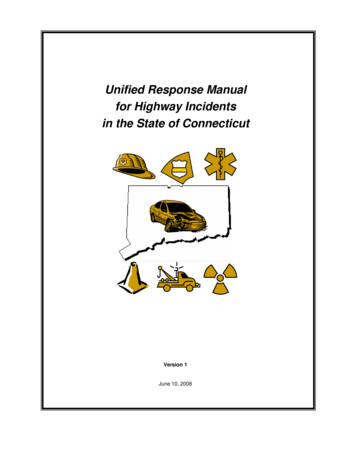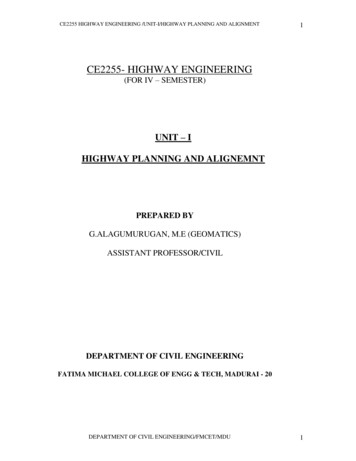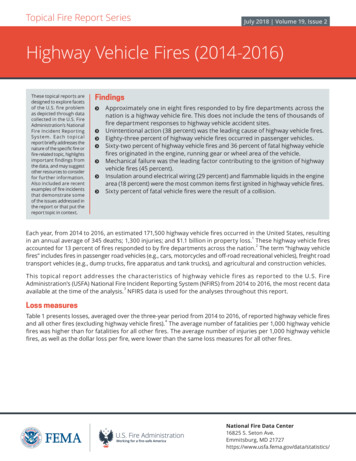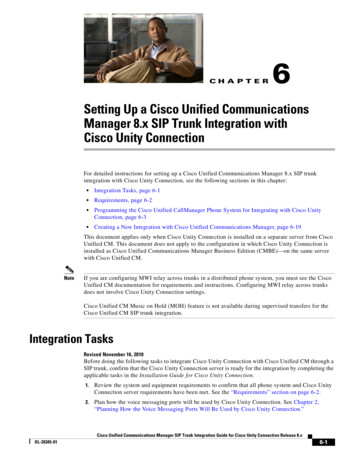
Transcription
Unified Response Manualfor Highway Incidentsin the State of ConnecticutVersion 1June 10, 2008
Unified Response Manual for Highway Incidents in the State of Connecticut
Unified Response Manual for Highway Incidents in the State of ConnecticutTable of Contents1 Introduction. 11.1 Purpose .11.2 Overview.11.3 Intended Use .11.4 Coordination .11.5 Incident Command.21.6 Incident Classification.32 Operational Considerations. 92.1 Initial Approach.92.1.1Personal Safety .92.1.2Incident Size-Up .92.1.3Personal Injury/Fatality .102.1.4Potential Crime Scene.102.2 Emergency Management Actions .102.3 Recovery Actions .113 Agency Actions. 123.1 Law Enforcement .123.1.1First on the Scene .123.1.2Joining an Established Command .123.1.3Incident Management Actions .123.2 Fire and Rescue .133.2.1First on the Scene .133.2.2Joining an Established Command .133.2.3Incident Management Actions .133.3 Emergency Medical Service.143.3.1First on the Scene .143.3.2Joining an Established Command .143.3.3Incident Management Actions .143.4 Traffic Control/Transportation.153.4.1First on the Scene .153.4.2Joining an Established Command .153.4.3Incident Management Actions .153.5 Towing and Recovery.163.6 Environmental Protection .173.7 Medical Examiner .184 Post-Incident Considerations . 195 Summary of Duties and Responsibilities . 20-i-June 2008
Unified Response Manual for Highway Incidents in the State of ConnecticutList of AppendicesAppendix A: Acronyms . 22Appendix B: Typical Incident Command System . 23Appendix C: Applicable State Statutes . . 24Appendix D: Connecticut Highway Incident Management Policy . 25Appendix E: Connecticut Quick Clear Policy . . 28Appendix F: Temporary Traffic Control Devices . 30Appendix G: HAZMAT Recognition Check List . . 32Appendix H: Establishing Control Zone & Vehicle Positioning On Scene . 33Appendix I: T.R.A.A. Vehicle Towing Guide . . 35Appendix J: DOT Highway Operations Diversion Route Plans . . 38Appendix K: After Action Reviews . 39Appendix L: Contact Information . 43NOTES 45- ii -June 2008
Unified Response Manual for Highway Incidents in the State of Connecticut1INTRODUCTION1.1PurposeThis manual serves as a field reference to enhance interagency coordination of first responders at traffic incidentscenes on limited-access highways in the State of Connecticut. This manual suggests guidelines that do not replace,but rather enhance existing policies and procedures.1.2OverviewThis manual focuses on unified response to highway incidents on limited-access highways in the State ofConnecticut. It serves as a reminder of the available resources and interagency collaboration considerations. It isintended to reduce confusion, reduce potential conflicts, and facilitate communication among agencies responding toincidents.This manual is designed to provide general operational considerations, specific agency-related actions, general postincident considerations, and resource information, as shown in the appendices. The appendices include: a list ofacronyms; a NIMS-compliant, typical Incident Management System (IMS) structure; useful contact information; aguide to temporary traffic control devices; and the T.R.A.A. Vehicle Towing Guide1.1.3Intended UseThis manual is intended to support the incident management goals of improving the safety of incident responders,reducing the potential of secondary incidents, and reducing congestion delay on the transportation system. Pleasenote: This manual is not a substitute for agency-specific training classes and manuals, but is intended to supplementincident responders’ appropriate prior training and experience. This manual summarizes useful incident management principles and considerations. This manual does not recommend a one-size-fits-all approach to incident response and management. Eachincident must be assessed with careful regard given to its unique characteristics and hazards. This manual serves as a reminder of available resources and terminology. The manual is intended to evolve and be revised to reflect advances in incident management techniques,technologies, and agency policies and procedures. This manual is consistent with the National Incident Management System’s Command and Managementcomponent, but does not focus on other NIMS components, such as Preparedness, Resource Management,Communications and Information Management, Supporting Technology, and Ongoing Management andMaintenance.1.4CoordinationEffective and efficient incident management requires multi-agency coordination beyond the scope of this manual.Proper multi-agency coordination requires that:12 Incident response agencies should meet together periodically to discuss capabilities and limitations. Incident response agencies should meet together periodically to pre-plan typical equipment staging, responseroutes, and practices. 2Incident response agencies should meet together periodically to review and update diversion route plans . Each Incident response agency should conduct incident response and management training and participate incross-training with other responding agencies. Incident management stakeholders should periodically review and update this manual and other incidentmanagement materials and documentation.Used with permission from T.R.A.A.Refer to Appendix J for a list of existing DOT diversion route plans.-11. IntroductionJune 2008
Unified Response Manual for Highway Incidents in the State of Connecticut 1.5Incident response agencies may enlist the assistance of RPAs/COGs in distributing incident managementmaterials and information to emergency responders throughout the state.Incident CommandThe Incident Command System (ICS) is a widely-recognized approach to incident management. ICS establishes aunified organizational structure to coordinate interagency response efforts that is consistent with NIMS. ICS isscalable in response to escalating incident hazards. In incidents involving multiple jurisdictions or multi-agencyinvolvement, Unified Command (UC), an application of ICS, is used to allow for a single, collaborative managementapproach. Unified Command is based on shared authority that changes commanders as an incident progressesthrough different phases. A typical incident command system is presented in Appendix B.3Under current Connecticut statutes , the following considerations govern incident command: The first responder to arrive on scene assumes incident command until a specialized agency arrives. Forhighway incidents, State Police are typically the first on the scene, and the highest-ranking officer assumesincident command. The highest ranking State Police officer retains incident command unless a fire service is responding or onscene. In that event, the fire chief or fire officer-in-charge assumes incident command with physical transfer ofcommand occurring once the fire service arrives on scene. Following the completion of the fire suppressionand rescue operations phases, incident command is typically transferred back to the highest ranking StatePolice officer at the scene. Depending on the incident, other agencies may also assume incident command for various phases (e.g., DEPfor the hazardous material identification, mitigation, and containment phases or the military for a weapons spillcontainment phase). Following the completion of these phases, incident command is then typically transferredback to the highest ranking State Police officer at the scene. Incident responders must continually re-assess the incident to ensure that the ICS is being utilized properly inresponse to changing incident conditions and hazards.An Incident Commander is responsible for not only managing conditions at the scene, but also for managingconditions along the resulting queue. Incident Commanders should also: Explicitly establish and transfer command, as necessary. Establish overarching objectives consistent with the multiple goals of effective incident management (ensuringthe safety of incident responders, reducing the potential of secondary incidents, and reducing congestiondelay.) The incident commander must establish a lane closure pattern in coordination with other agencies as part ofthe initial actions. All initial responders must be advised by radio and other means how and where to park toconform to the lane closure plan. Lead representatives from each agency must advise all additionalresponders including mutual aid how/where to park in conformance with this lane closure plan. See AppendixH for additional information and guidance. Develop and issue assignments. Establish specific, measurable objectives for various incident management functional activities and directefforts to attain established objectives. Effectively communicate information regarding the unique hazards and characteristics of the incident todispatch and fellow responders. Document results.As part of a Unified Command, designated agency representatives should jointly determine objectives, strategies,plans, and priorities and work together to execute integrated incident operations and maximize the use of assignedresources. Communications among responders should be managed in accordance with the incident commandsystem4.34CT General Statute Section 7-313e. Refer to Appendix C.Refer to Appendix B.-21. IntroductionJune 2008
Unified Response Manual for Highway Incidents in the State of Connecticut1.6Incident Classification5The following incident classification scheme is proposed for quickly communicating an incident’s scope and severity.This classification does not in any way replace the need for detailed communication of each incident’s uniquecharacteristics and hazards. Typically incident classification would occur as part of the initial approach of the firstresponder to arrive on scene and then periodically re-evaluated by the Incident Commander throughout the durationof the incident. Level 1 Incidents: These are minor incidents involving only property damage and not requiring fire and rescueservices. At least one traffic lane in each direction must remain unobstructed. Level 2 Incidents: The most common type of incident, Level 2 Incidents involve personal injuries and/or fireand rescue activities. For Level 2 Incidents, at least one traffic lane in each direction must remain unobstructedand all spills can be contained by the responding fire and rescue agencies.o Level 2 Haz Mat: spills can be contained by the responding fire and rescue agencies but does notrequire Environmental Clean Up. 1-3 hours for incident mitigation.Level 3 Incidents: Level 3 Incidents may also involve personal injuries and fire and rescue activities.However, for Level 3 Incidents, 2 or more traffic lanes in one direction are obstructed, and at least one trafficlane is open in both directions, and/or there are spills requiring specialized containment/cleanup.oLevel 3.0 HazMat: Minor release 25 gallons, contained, requires Vac Truck for removal (possiblyinto a Catch Basin), petroleum (diesel fuel, or Passenger Vehicle Gasoline) 1-3 hours for incidentmitigation.oLevel 3.1 HazMat: Same as above, but spill is larger ( 25 gals, 1 or more saddle/fuel tanks) affectsshoulder or median and requires excavation equipment. 2-6 hours for incident mitigation.Level 4 Incidents: Level 4 Incidents involve any of the following:oA fatality.oAll traffic lanes in one or both directions are obstructed.oThe presence of HAZMAT or CBRNE indicators.oLevel 4.1 HazMat: Incident involves a commercial bulk petroleum vehicle that may or may notneed to be off-loaded. 4-8 hours for incident stabilization.oLevel 4.2 HazMat: Incident involves Commercial Bulk or non-bulk Vehicle (i.e. – tanker or boxtruck with mixed load of Hazardous Materials) with potential or actual release/chemicalreaction. 4-8 hours for incident stabilizationoLevel 4.3 HazMat: Incident involves Commercial Bulk or non-Bulk Vehicle with actualchemical release/chemical reaction. 8 hours for incident stabilizationoSuspicion of terrorism or an ongoing criminal act.oSignificant damage to or the collapse of a major transportation infrastructure component.oMilitary weapon spills.5Most of this section has been adapted from the Massachusetts Highway Department’s Unified Response Manual for RoadwayTraffic Incidents, July 1998.-31. IntroductionJune 2008
Unified Response Manual for Highway Incidents in the State of ConnecticutINCIDENT LEVEL MATRIXCriteriaTraffic Level1Debris ordisablement234XXXXInjuriesFatalityXHazmat: Spillrequiring specialcleanup orcontainmentXCBRNE, suspicionof terrorism orongoing criminalact, significantdamage to majortransportationinfrastructure, ormilitary weaponsspillX1 or more lanesblocked; at least 1lane open in bothdirectionsX2 or more lanesblocked; at least 1lane open in bothdirectionsXAll lanes blocked, ineither 1 or bothDirectionsMinimum durationXX30 Minutes1 Hr1 Hrs2 HrsTable 1: Incident Level MatrixTable 1 depicts the criteria used to define each incident level. For example, a 2-car accident, blocking 2 travel lanes,personal injury, a duration of an hour with a little radiator fluid and gas would be a Level 3 incident.-41. IntroductionJune 2008
Unified Response Manual for Highway Incidents in the State of ConnecticutINCIDENT AGENCY RESPONSE REXXXEMSXXXXXXX*X*X*TOWINGX*DEPMEX*Haz/Mat TeamX**If requiredTable 2: Incident Agency Response MatrixTable 2 depicts which agencies may be required to respond to a specific incident level. These Incident Levelsprovide for consistent and effective response to roadway incidents. The intent of the URM is to maintain flexibility fordecision-making, when activating a response level consistent with the nature of the incident. For example, a DMVdoes not warrant the response comparable to a TTU rollover involving personal injury.-51. IntroductionJune 2008
Unified Response Manual for Highway Incidents in the State of ConnecticutDOT RESPONSE MATRIXEquipmentLevel1234Cones, Drums, ArrowboardXXDump Body SanderXXLoaderXVMS TrailerXOverhead VMS ActivationDispatch CHAMP VanXXXXXXXXXDOT SupervisorDiversion Sign packageXTable 3: Pre-planned DOT Agency ResponseCT STATE POLICE RESPONSE MATRIXEquipmentLevelPatrol TrooperSupervisor (Sgt.)1234XXXXXXCommander (Lt or higher)XEmergency Services UnitXTruck SquadXAccident ReconstructionistXXPublic Information OfficerXXTable 4: Pre-planned CT State Police ResponseLevel 1 Incidents: minor incidents; property damage only; and at least one lane in each direction open.Level 2 Incidents: may involve personal injuries and/or fire and rescue activities; at least one lane in each directionopen; and spills, if any, do not require environmental clean-up.Level 3 Incidents: two or more lanes in one direction are obstructed; however, at least one lane in each directionopen; and/or there are spills requiring specialized cleanup.Level 4 Incidents: all lanes in one or both directions blocked; a fatality; HAZMAT or CBRNE indicators; suspicionof terrorism or an ongoing criminal act; damage to transportation infrastructure; and/or military weapon spills.-61. IntroductionJune 2008
Unified Response Manual for Highway Incidents in the State of ConnecticutFIRE DEPARTMENT RESPONSE MATRIXEquipmentLevel1234Command CarXXXFire Pumper(s)XXXRescue Truck(s)X*XXX*X*Haz Mat TruckDecon Trailer/Specialized EquipmentX*Table 5: Pre-planned Fire Department ResponseLevel 1 Incidents: minor incidents; property damage only; and at least one lane in each direction open.Level 2 Incidents: may involve personal injuries and/or fire and rescue activities; at least one lane in each directionopen; and spills, if any, do not require environmental clean-up.Level 3 Incidents: two or more lanes in one direction are obstructed; however, at least one lane in each directionopen; and/or there are spills requiring specialized cleanup.Level 4 Incidents: all lanes in one or both directions blocked; a fatality; HAZMAT or CBRNE indicators; suspicionof terrorism or an ongoing criminal act; damage to transportation infrastructure; and/or military weapon spills.-71. IntroductionJune 2008
Unified Response Manual for Highway Incidents in the State of ConnecticutDEP RESPONSE MATRIXRespondersLevelDEP ERC (2)23.13.24.14.24.3X*XXXXXXXXXDEP ERC (2)XDEP ERC (2)EquipmentSpill VanX*XXXXXForemanX*XXXXXXXXXXXXXXXXXXXXVac TruckRoll OffExcavatorER VanXSupervisorTable 6: Pre-planned CT DEP Agency ResponseNotes:* Only if neededERC Emergency Response Coordinator (minimum two ERC respond to an incident)DEP Responders come in individually equipped vehiclesEquipment as noted above is provided by CT DEP Contractor ResourcesLevel 2– contained by local fire department, does not requires environmental clean upLevel 3.1– 25 gallons, requires vac truck for fuel removal / clean upLevel 3.2– 25 gallons, requires soil excavation along highwayLevel 4.1– Commercial Bulk petroleum vehicle that may or may not need to be emptiedLevel 4.2– Commercial Bulk or non-Bulk vehicle with potential chemical release / reactionLevel 4.3– Commercial Bulk or non-Bulk vehicle with chemical release/reaction-81. IntroductionJune 2008
Unified Response Manual for Highway Incidents in the State of Connecticut2OPERATIONAL CONSIDERATIONS2.12.1.1Initial ApproachPersonal Safety Confirm the exact location of the incident and communicate incident location to dispatcher or home officeas accurately as possible. Please take advantage of mile markers to aid in this effort. Observe traffic volume and speed. Observe conditions of the road surface (to ensure adequate protection zone according to safe trafficstopping distance requirements). Observe number of traffic lanes blocked. Evaluate and implement personal protective measures, including whether or not protective gear iswarranted, according to your agency’s standard operating procedures. Establish control zone to protect personnel while allowing traffic flow around the incident, if possible.6 2.1.26789oRemember to set up the control zone in accordance with the Manual on Uniform Traffic Control7Devices (MUTCD) . Be sure to provide an adequate advance warning zone, transition zone,and buffer zone based on road geometrics, weather conditions, and visibility.oConsider emergency equipment placement without unnecessarily impeding traffic flow.oConsideration should be given to carrying a minimum of 6-8 traffic cones on respondingvehicles, especially those that are likely to be first or among the first to respond to the scene ofan incident.oUse arrow boards, such as those provided on CHAMP vehicles, if available.oConsider detouring traffic around the incident by giving directions to motorists.oCoordinate with DOT to formally establish a control zone and traffic control at the incident site,based on number of lanes obstructed and the incident size and severity.Consider use of pre-existing diversion route plans such as the DOT Highway Operations Diversion RoutePlans8.Incident Size-Up Assess incident severity, personal injury, etc., and classify the incident according to the proposedclassification scheme and/or your agency’s standard operating procedures. Observe Hazmat9 or CBRNE indicators (if in doubt refer to your agency’s Hazmat guide.) Remember that traffic backup can spread very quickly depending on the location, time of day, and day ofthe week. Remember that motorists involved in property-damage-only accidents are required to move their vehicles10off of the limited access highway . Assess the need for help from law enforcement, fire and rescue, DOT, DEP, towing and recoveryservices, etc. All spills regardless of quantity of anything other than clean water must be reported to DEP. DEP mayauthorize a spill contractor to respond before DEP arrives at the scene. If a hazardous material isinvolved, DEP is also to be notified to ensure that clean-up meets DEP standards.Refer to Appendix H for information on “best practices” regarding positioning of emergency vehicles.Contact the Connecticut Department of Transportation for more information on the MUTCD, if needed.Refer to Appendix J for a list of existing DOT Diversion Route Plans.Refer to Appendix G for a Hazmat Recognition Check List.10CT General Statute Section 14-224(d). Refer to Appendix C.-92. OperationalConsiderationsJune 2008
Unified Response Manual for Highway Incidents in the State of Connecticut2.1.32.1.42.2111213 If any food products are compromised or are potentially compromised as a result of an incident, theConnecticut Department of Consumer Protection must be notified. If the food products include dairyitems (milk, eggs, etc.) the Connecticut Department of Agriculture should also be notified. Inspectorsfrom these agencies will make the determination as to whether or not these products are safe forcontinued transport. The DEMHS is not usually notified of traffic incidents unless there is a suspected connection to terrorismor state security. All weapon spills should be reported to the Connecticut Department of the Military. This agency will thendirect this information to the appropriate service agency for weapon containment and transport. Report all observations to dispatcher or home office. Notify DOT Highway Operations Centers as appropriate. Notify the media or PIO as appropriate, according to your agency’s standard operating procedures.Personal Injury/Fatality Observe conditions of the victim(s)11. Observe indicators of hazardous substances, dangerous conditions, or possible terrorist events. Report all observations to dispatcher or home office. Consider rendering aid appropriate to the level of training/certification. (Remember that Connecticut has12a Good-Samaritan law .) Follow local protocol. Consider the need to call the Office of the Chief Medical Examiner (OCME.) (Thisfunction is usually performed by law enforcement.)Potential Crime Scene You may be on the scene of a potential crime; discuss it with the on-scene law enforcement officers, ifavailable, or call their facilities. Consider preserving the scene during your emergency response actions.Emergency Management Actions Isolate/secure the scene, deny entry if warranted. Establish command in accordance with ICS principles. Establish and declare the Incident Command Post location away from the incident scene. Establish a safe staging area (or temporary on-site parking area) with the least traffic interference. Implement the Incident Command System Re-assess emergency vehicle and equipment placement to provide personnel protection whileminimizing impacts on traffic flow at the scene. Consider minimizing the use of emergency lights since they may distract motorists and contribute tosecondary incidents. Call DOT Highway Operations Centers, as appropriate, to request traffic management/lane closureassistance at the site and in the region, including changes in the traffic signal control scheme, electronicchangeable message signs (CMS), debris removal, sand for road surface treatment, etc. Describe the traffic situation, safety, and traffic control needs to DOT to obtain the appropriateequipment.13as the situation warrants.Obtain guidance from EMS on the basic indicators.CT General Statute Section 52-557b. Refer to Appendix C.Refer to Appendix B.- 10 2. OperationalConsiderationsJune 2008
Unified Response Manual for Highway Incidents in the State of Connecticut2.31415 Remember that depending on the incident location and severity, the implementation of pre-existingdiversion route plans14 may be appropriate. Remember that law enforcement will need to talk to the victims for accident investigation. Remember to let law enforcement know where the victims are being sent. Consider preservation of evidence during search and rescue operations. Coordinate with law enforcement if potential evidence is found during emergency operations. Coordinate information for PIO, if applicable. Remember to have dispatch notify local school transportation agencies, transit agencies, and privatesector organizations concerning road closures, as appropriate. For Level 3 and Level 4 incidents, notify the Department of Emergency Management and HomelandSecurity. Phone number is listed in Appendix L. Consider requesting transportation assistance and/or rehabilitation buses from local transit agencies. Establish a rehabilitation area for responders, if warranted. Remember to account for all responders on scene.Recovery Actions Remember that evidence may disappear with time or be lost due to response activities. Coordinate with law enforcement if potential evidence is found, or if re-location of potential evidence isnecessary. For incidents involving a fatality, consider providing transportation or emergency escort for MedicalExaminer or Forensic Investigator. Consider describing the tow and recovery needs rather than specifying equipment. Refer to TRAAVehicle Towing Guide for assistance15. Consider coordinating with the towing and recovery companies to clear the road as soon as possible(including setting priorities for towing). Remember to notify all agencies involved when the roads have been re-opened, including specifically theDOT Highway Operations center so they can reset travel advisory messages on CMS. Remember to take notes on the lessons learned or issues, or both, for after-action reports or incidentcritiques, including responders’ names and con
Each Incident response agency should conduct incident response and management training and participate in cross-training with other responding agencies. Incident management stakeholders should periodically review and update this manual and other incident management materials and documentation. 1 Used with permission from T.R.A.A.











